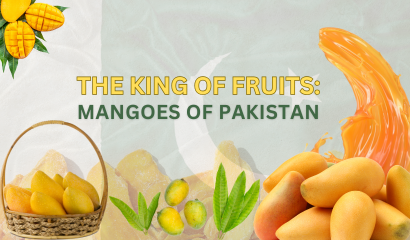- Your cart is empty
- Continue Shopping

The King of Fruits: Mangoes of Pakistan
Introduction
Mango — the “King of Fruits” — holds a special place in the hearts (and tastebuds) of millions. Among the countries that produce mangoes, Pakistan stands out as one of the world’s top exporters, known for its rich, juicy, and aromatic varieties. With a blend of fertile soil, warm climate, and centuries-old cultivation methods, Pakistan produces mangoes that are not just fruits, but a cultural symbol and a source of national pride.
1. Mango Varieties in Pakistan
Pakistan is home to more than 250 varieties of mangoes. Each has its own unique flavor, color, aroma, and texture. Some of the most famous ones include:
- Sindhri – One of the earliest varieties to hit the market (May–June), large in size, golden-yellow, and incredibly sweet.
- Chaunsa – Perhaps the most celebrated variety, Chaunsa is known for its rich aroma, sweet taste, and minimal fiber. It becomes available mid to late summer.
- Langra – Medium-sized, green-skinned, and very juicy, Langra is a popular variety often consumed fresh or in juices.
- Anwar Ratol – A smaller mango, known for its exceptional sweetness and strong fragrance, cherished especially in Punjab.
- Dussehri, Baganapalli, and Neelum – Other regional favorites with loyal followings.
2. Mango Season in Pakistan
The mango season in Pakistan typically runs from May to September, depending on the region and variety. Early-season mangoes come from Sindh, while Punjab’s harvest follows in June and July.
3. Mango Production Regions
The two major mango-producing provinces are:
- Sindh (Mirpurkhas, Tando Allahyar, Hyderabad)
- Punjab (Multan, Rahim Yar Khan, Bahawalpur, Muzaffargarh)
These regions offer the ideal climate and soil conditions for mango cultivation — hot temperatures, ample sunlight, and rich alluvial soil.
4. Pakistan’s Mango Exports
Pakistan is among the top 5 mango exporters globally. The country exports mangoes to:
- Middle East (UAE, Saudi Arabia, Qatar)
- Europe (UK, Germany, France)
- North America (USA, Canada)
- East Asia (China, Malaysia, Hong Kong)
In recent years, Pakistani mango exporters have also tapped into organic and value-added products, such as dried mangoes, mango pulp, and mango juice.
5. Cultural Significance
Mangoes are more than just a fruit in Pakistan — they’re a symbol of hospitality, celebration, and summer. Mango parties and family gatherings featuring mango desserts, shakes, and traditional dishes like mango pickle (achar) are common during the season.
6. Challenges and Opportunities
While Pakistani mangoes enjoy global recognition, the industry faces several challenges:
- Post-harvest losses due to poor handling and transportation.
- Lack of cold storage facilities for export-grade mangoes.
- Pest and disease management affecting yield and quality.
However, with investments in modern agriculture practices, packaging, and global certifications (like GlobalGAP), the mango industry in Pakistan has great potential to grow and expand internationally.
Conclusion
Pakistan’s mangoes are not just agricultural products — they are a source of identity, pride, and economic potential. Whether it’s the first juicy bite of a Chaunsa in June or a mango milkshake at a roadside stall, the fruit continues to be a seasonal delight cherished across the world.
As the world demands better, fresher, and tastier fruit, Pakistan’s mangoes are ripe for global leadership — quite literally!
